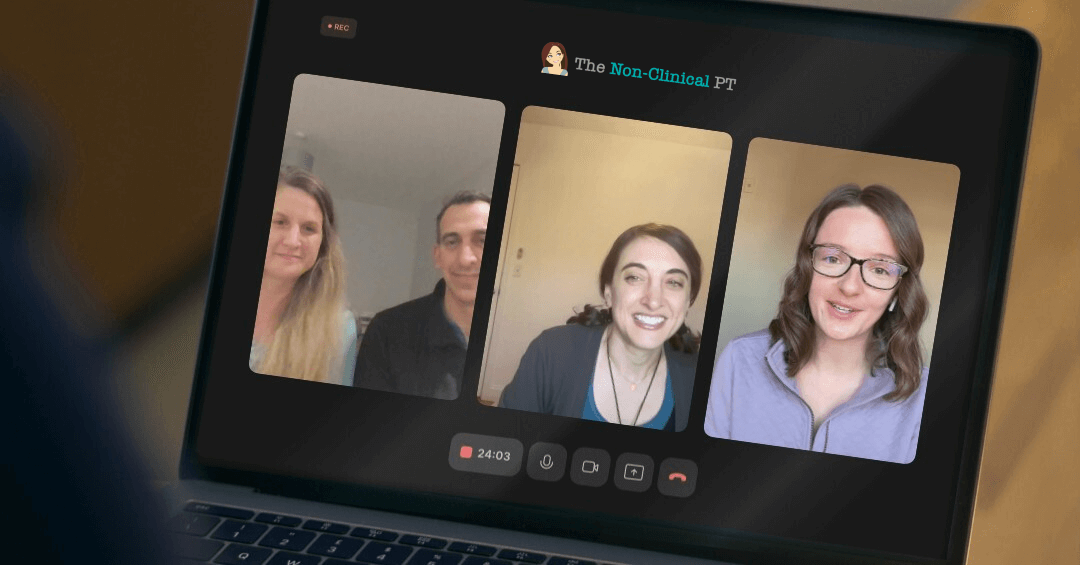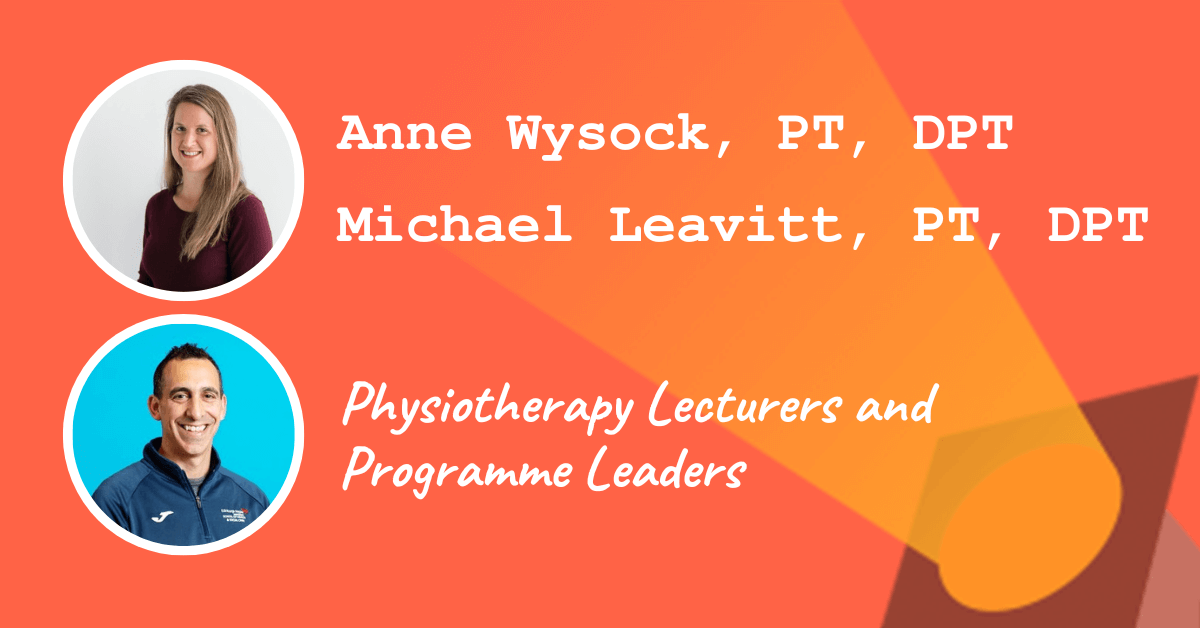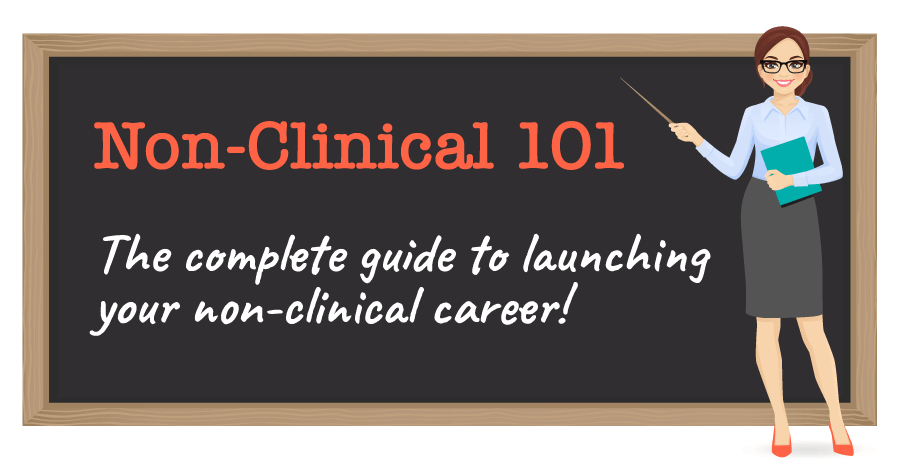This week’s spotlight is on Anne Wysock, PT, DPT and Michael Leavitt, PT, DPT, who are now Physiotherapy Lecturers and Programme Leaders in Scotland!
This post may contain affiliate links or codes. This won’t increase your cost, but it helps keep TNCPT alive, and free of annoying ads! Thank you for your support. 🙂
What is your full name, title, and company name for your current, primary role?
Anne (Annie) Wysock, PT, DPT — Physiotherapy Lecturer and Programme Leader, Queen Margaret University

Michael Leavitt, PT, DPT — Physiotherapy Lecturer and Programme Leader, Edinburgh Napier University

What additional roles do you currently have?
Annie: Occasional private practice in MSK.
Where are you located?
Edinburgh, Scotland.
Please refrain from contacting our spotlight participants on social media. There are thousands of readers just like you out there. 🙂 Please ask your questions in the comments on this blog post.
If you’re a Non-Clinical 101 student, you can network with many of our spotlight participants in the alumni groups!
Where did you go to PT school, and what year did you graduate?
Annie and Michael: Midwestern University, May 2010.
What did you do when you first finished school, and for how long?
Annie: I began working full time in an outpatient orthopedic clinic for four and a half years.
Michael: I began working full time in an outpatient neurological rehab clinic for 11 years.
In what setting(s) did you work, and what types of patients did you treat?
Annie: I’ve worked in:
- Outpatient orthopedics: musculoskeletal conditions, post-operative rehab, sports rehab, older adult, joint replacement
- School-based pediatrics: children age 3-21, primarily elementary school age, with a wide range of neurological conditions and varying levels of severity
I also occasionally work in private practice now, treating musculoskeletal conditions.
Michael: I’ve worked in:
- Outpatient neuro: expansive treatment of neurological conditions, including stroke, MS, TBI, concussion, Parkinson’s, ALS, and many others
- Acute care
- Subacute rehab
What did you enjoy about your early roles? What didn’t you enjoy?
Annie: I enjoyed working with musculoskeletal and orthopedic conditions to enable patients to return to function, activity or sport. I enjoyed learning how to incorporate specific exercise and manual-based interventions to reach goals. I enjoyed the connection with patients.
I did not like the productivity requirements, which made the role more difficult as pressures increased.
Pressure to double book and overlap patients significantly increased my work stress and decreased the quality of treatment I could provide. I did begin to get burnt out, and when I had my first child, I knew I had to switch settings.
Michael: I enjoyed the challenge of working with neurologic impairments and being able to see results and success in often very difficult situations and conditions. I enjoyed the problem-solving nature of adapting and modifying treatments, so patients could succeed. I personally liked working with the complexities that arise within the neuro populations I treated.
This role was quite challenging physically at times. It was also difficult with some patients in regards to compliance and liaising with family members. This role was challenging from a work-management perspective. From a corporate and managerial perspective, I was not allowed to deliver services the way I would like.
What else have you done since then, prior to your current role?
Annie: After working in outpatient orthopedics, I moved into school-based physical therapy services. This was a huge learning curve for me, but I then worked for five and a half years in this setting and really began to enjoy my role.
When and why did you decide to do something non-clinical?
Annie and Michael: We decided to make a big change for our family. We had always considered a non-clinical role, but we were sort of stuck in our clinical position due to our massive student loans.
Once we luckily had our student loans forgiven through the Public Service Loan Forgiveness program, we looked for something new.
This is when Michael found a physiotherapy lecturer role opening at a university in Scotland. And we went for it.
What are you doing these days?
Annie: I am currently working full time as a physiotherapy lecturer and the programme leader for the MSc pre-registration physiotherapy program at Queen Margaret University. This role involves program management, program development, student relations, teaching, and research.
Michael: I am currently working full time as a physiotherapy lecturer and the programme leader for the MSc pre-registration physiotherapy program at Edinburgh Napier University. This role involves program management, program development, student relations, teaching, and research. I am actively involved in various research projects looking at head injury, impact, and concussion in sports.
Are you still treating patients, or are you solely non-clinical?
Annie: I occasionally will see MSK patients privately in their home.
What percentage of your time is spent clinically vs. non-clinically?
Annie: Very minimal clinical time currently, as my full-time role is quite time intensive.
How long have you been in your current role?
We’ve been in our current roles since May 2021.
Did you get any special certifications or training along the way to help you get into your current role?
Not prior. Since beginning our new roles, we have both undertaken a post-graduate certificate in professional and higher education.
How did you find your job? Did you apply or find it through a connection?
We found our jobs directly through the university websites.
Did you do anything special to your resume and cover letter to land the job?
We had to modify our resume to fit UK formatting for CVs. We also researched cover letter formatting and expectations for academic roles in the UK.
What was the interview like for the physiotherapy lecturer role?
We both had our interviews online/remotely. Both interviews were with a panel, likely the head of the university school or department and other relevant members of staff. You may be required to do a short presentation or teaching session based on a prompt.
How have people reacted to you leaving patient care?
Most people have been supportive and encouraging.
What’s a typical day or week in the life like for you? What types of tasks and responsibilities fill your time?
We hold similar roles, which includes day-to-day management of:
- Student issues and concerns, including placements
- Development and delivery of teaching content, including development of assessments/exams
- Teaching on various modules/courses in the form of lectures, seminars, practical sessions, etc.
- Constant program review and quality enhancement measures
- Supervision of students on research dissertations
- Our own research development, writing, and knowledge exchange
What are some of the rewards of your role? What are the biggest challenges?
Rewards: We enjoy working with students, motivating the future workforce, and having the opportunity to influence education hopefully for the better. Being able to conduct relevant research in our own areas of interest has been great.
Challenges: This job is around the clock, and we find it difficult to always switch off. We can work at night, weekends, etc. There are always tasks and student issues that arise, and at times it can be very busy and stressful during the academic year.
How did your clinical background prepare you for this role? Which skills transferred?
Both of our clinical backgrounds were essential for us within our current roles.
Now working in academia, we feel it is even more important that a strong clinical background should underpin anyone who goes into teaching. It is essential that we understand what clinical practice looks like—and also keep up to date with this—in order to relate to students.
Physical therapy IS teaching and education, so it transfers nicely into a teaching role.
Roughly speaking, how are the hours and pay compared to patient care?
Generally speaking, hours are more flexible, though there are days/weeks that are quite long, depending on your teaching load. We can also work in a hybrid fashion, thus we can work from home on days without in-person meetings or teaching.
Pay is another discussion, especially having moved to the UK. On first look, pay is less than in an equivalent position in the US. Directly, we both took cuts in pay to move here.
However, it is important to know that you cannot compare pay from the US to the UK, as standards of living are different. This would be worth some further discussion.
We sat down with Annie and Michael to discuss all this and more in a brand-new bonus interview in Non-Clinical 101!

What type of person do you think would do well in your physiotherapy lecturer role?
You need to be a good public speaker and come across as friendly and encouraging. You need to be a team player. You should have good organizational skills, as you will have to manage a lot of things at once.
Do you work remotely or onsite?
Hybrid.
Does your organization hire PT, OT, or SLP professionals into non-clinical roles? If so, what type of roles?
Roles for lecturers do come up occasionally. At QMU, we have PT (Physiotherapy), OT, and Speech and Language programs. At ENU, there is a PT and OT program. The most common roles which can arise are lecturer positions.
Did you read any books, take any courses, or do anything special overall to get you where you are today?
As mentioned prior, we have both gotten our post-graduate certificates in professional and higher education, which we did through our affiliated universities where we work. This could be something to look into if you want to have a foot up in the application process.
What is a typical career path for someone in your physiotherapy lecturer role?
You typically start as lecturer and can take on various leadership roles. For example, we are now both programme leaders.
Based on the hierarchical promotion ladders here, the next level would be associate professor, then professor. These are quite in-depth and lengthy processes.
Other aspirations could be to become a head of a department, dean of the school, or possibly higher.
What is next for you? What are your high-level career aspirations?
Annie: I am hoping to apply for promotion within the next few years to an associate professor role, but I need more publications to get there. In my current life, I am trying to just stay steady, as we have three young boys, and life can be incredibly busy and challenging at times.
Michael: I am also hoping to apply for promotion within the next year or so. I have numerous research projects and grants ongoing, which I would love to see come to fruition and some publications finalized. I aim to work my way up in the academia world, with hopes of associate professor to come along next.
What would you recommend to someone who is considering going into a role like yours? Do you have any special words of wisdom for the readers?
We don’t want to sugar coat and say that this is easy. It was a huge transition to move to a foreign country, begin work in a foreign academic world, and learn all the ins and outs of a new system. But we did it. So, if we can, others can, too.
Any higher education teaching experience would go a long way (example: teaching in an OTA or PTA program if you cannot get into a PT, OT or SLP program). Also, consider guest lecturing or teaching. Think about ways you can highlight education within your current role. If you can get research or publications, that would also give you a huge step up.
Do you have any special advice for others who want to follow in your footsteps?
We are hoping to do a podcast, as there are so many steps and things to consider if you are going to move abroad and break into academia. Securing a job, going through the visa process, moving; it is a lot.
You have to fully be ready to commit and put your mind to it, or it won’t happen. We really would love to help others who’d consider such a massive move or change.





